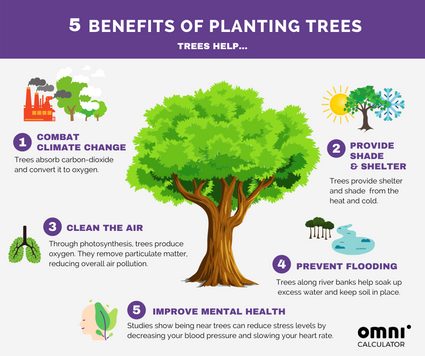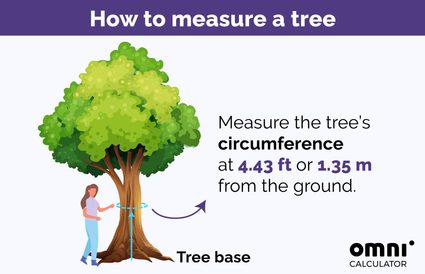Tree Benefits Calculator
During the COP26 global climate summit, over 100 countries and the European Union (holding more than 85% of the world's forests!) pledged to end deforestation by 2030! They inspired us to create this tree benefits calculator. We did some research and found that we should be grateful to trees, and not just for the oxygen we breathe. They come with a list of benefits — both environmental and economic. In the calculator, you can find out how much oxygen your neighborhood's trees produce and how much money you save thanks to them. We also collected a list of tips for those who want to help the planet and plant even more trees.
Benefits of having trees in your neighborhood
Trees do much more than produce oxygen and absorb carbon dioxide. They also have a significant impact on the environment, economy, and even our mood.
For one, both single trees and forests create a habitat for wildlife — and the presence of a variety of animals is an indicator of a healthy environment. They also improve air quality — they stop dust from spreading and absorb some toxic chemicals. Additionally, they cool the air down by evaporating water. In cities, where it gets scorching hot in the summer because of the overuse of glass and concrete, trees help lower the temperature. The list goes on! Trees help reduce noise. They also retain water in the ground so that it is more resistant to flooding.
You now know what can happen when trees are around. But what does it mean for you?
In the long run, trees pay for themselves. The costs of maintaining forested areas are even three times lower than the money we can save thanks to trees! Because trees cool down the air, we use less air conditioning. Additionally, we save on air and water purification and rainfall retention. Trees also increase property value.
Apart from being good for our wallets, trees are also good for our mental and physical health. Looking at trees helps reduce stress and anxiety. People after surgeries recover faster when they have rooms overlooking nature. They bring the community together. And to top all of that, trees are just beautiful to look at.
Are you in the mood to plant a tree yet? We have a tree spacing calculator that will help you to determine the correct distance for planting different types of trees.

How to use our tree benefits calculator
We couldn't call ourselves Omni Calculator if we didn't prove to you the benefits of trees in numbers! So, let's say you have a few trees in your garden, and you're thinking about cutting them down. With our calculator, you can find out why it wouldn't be a good decision. To use it, input four pieces of information:
- Tree type — you can choose between mixed, oak, Douglas fir, red maple, loblolly pine, American beech, common birch, and sugar maple.
- Circumference, measured at 1.35 m (4.43 ft) up from the highest point of ground at the tree's base. You can also use this value in the tree diameter calculator later.
- Number of trees.
- Period of time — the time you were able to benefit from the presence of trees.

After you input that information, our calculator will tell you:
- How much oxygen the trees produced;
- How much carbon dioxide they absorbed;
- Water to evaporate; and
- How much money you save on heating/cooling.
And if you're still not convinced that trees are valuable, use the tree value calculator to let the numbers prove you wrong!
10 recommendations on how to plant trees
So now you know why you should surround yourself with trees. But what if you don't have that many trees in your neighborhood? The answer is obvious — you could plant them. But how do you plant trees so that you help the environment and not harm it? With the solution come the scientists from the Royal Botanic Gardens in Kew in an interview with the BBC.
- Protect forests that already exist
Forests are not only trees. Forests are animals, plants, and fungi. They have their own systems of degradation and regrowth. Therefore, they have some degree of natural resistance to droughts, fires, and storms. You can easily see this if you look at how some parts of Australia looked a while ago and how they look now. Old forests also have better photosynthetic efficiency, so they take up more carbon dioxide.
- Local people should be the driving force of tree-planting projects
Trees are most beneficial to locals, because they're the ones that are going to be surrounded by them. That's why having locals be involved is the key to success.
- Ensure biodiversity
As we've said before, biodiversity is crucial for a thriving and resilient forest. That comes with many ecological, economic, and cultural benefits. Trees help cool the atmosphere in summer and warm it in the winter, so you save money on air conditioning. You can find out how much in our calculator.
- Choose the right spot
Pick a fitting location for tree planting. Think of places that once had natural forests. Don't try to plant trees in a desert in Arizona — that just won't go well.
- Let forests regrow on their own
Forests will regrow on their own. Don't brute force your help. If you're concerned about forests' condition, ask a local forester if there's something you can do to help.
- Use local but various tree species
Again, it's all about biodiversity. Use different species of trees, but if you live in Texas, don't plant trees that generally grow in Alaska and prefer cooler and more humid conditions. Think about which types of trees you can find growing naturally in the area, and avoid invasive species.
- Use tree seeds that will adapt to the climate
Consider how the local climate might change in the future. Plant seeds that can endure that.
- Have a plan
If you want to plant many trees, consider your budget and think of ways to get more for less.
- Trials are an opportunity to learn
Before planting many trees, check how experts would handle such a project. If it's possible, have a small trial. If everything goes well, start planting.
- Make it pay
Make sure it's affordable for everyone in the community, even the poorest.
We can't deny it. Trees have extensive benefits. But, unfortunately, they can't be the only solution to the problem. If we (not we as in you and me, but as in all countries and industries on Earth) don't stop using fossil fuels quickly, even if we plant billions of trees, we might not be able to stop global warming.